Welcome to the captivating world of Birds of Prey in Alabama. The state of Alabama is a haven for these magnificent creatures, boasting a rich diversity of avian predators that command the skies. From the soaring presence of eagles to the stealthy prowess of hawks and the haunting calls of owls, Alabama’s birds of prey contribute to the state’s vibrant ecosystem and offer a remarkable spectacle for nature enthusiasts and birdwatchers alike.
There are actually 33 birds of prey in Alabama but we are just focusing on the most common 19!
Here is a list of 19 of the most common birds of prey found in Alabama:
Turkey Vulture: Abundant throughout Alabama, often seen soaring in open areas, playing a vital role in the ecosystem by consuming carrion.
Red-tailed Hawk: These hawks are idespread in diverse habitats across Alabama, frequently observed soaring above open fields and forests.
Red-shouldered Hawk: Common resident found in swampy and wooded areas near water sources throughout the state, recognized by its reddish shoulders.
Cooper’s Hawk: Found in wooded areas, including suburban and urban environments, where they prey on smaller birds. They can be observed in parks and neighborhoods.
Bald Eagle: Healthy population in Alabama, particularly near water bodies such as rivers and lakes. Sightings of their impressive nests and soaring flights can be enjoyed in various national parks and wildlife refuges.
Great Horned Owl: Nocturnal predator, widespread in forests and urban areas across the state. Their haunting hoots can be heard in parks, nature reserves, and even suburban neighborhoods.
Osprey: Seen near waterways, including coastal regions and lakes. Look for their nests on platforms erected specifically for their use or perched on snags near bodies of water.
American Kestrel: Found in open habitats like farmlands, grasslands, and coastal areas. They hover in mid-air while hunting insects and small vertebrates.
Mississippi Kite: Summer resident in Alabama, favoring open woodlands and areas near rivers. They can be observed in locations such as the Wheeler National Wildlife Refuge.
Broad-winged Hawk: Migratory species that pass through Alabama in large numbers during migration, particularly over forests and woodlands.
Northern Harrier: Found in wetland areas, marshes, and open fields across Alabama. They are known for their low, gliding flights and hunting small mammals and birds.
Swallow-tailed Kite: Summer species found over wetlands and forests, catching prey in flight. They can be spotted in areas like the Mobile-Tensaw Delta.
Barred Owl: Resident species in forests and swamps, recognized by their distinctive “Who cooks for you?” call. Look for them in locations such as Bankhead National Forest.
Peregrine Falcon: Occasionally observed during migration along coastal areas or perched near tall structures such as bridges and cliffs, known for their high-speed dives.
Northern Saw-whet Owl: Elusive species found in dense forests across Alabama. They are predominantly nocturnal and recognized by their hooting call.
Sharp-shinned Hawk: Year-round resident in woodlands, skilled at hunting songbirds. They are known to visit bird feeders and can be observed in various locations.
Merlin: Seen in Alabama, particularly during migration. Look for them in suitable habitats such as open areas and coastal regions.
Northern Goshawk: Present in Alabama, but sightings may be less frequent. These large hawks are typically found in forested areas.
Eastern Screech Owl: Eastern screech owls are found in wooded areas across the state, these small owls are masters of camouflage and known for their haunting trills and whinnies.
Turkey Vulture (Cathartes aura)


Turkey Vulture Sound
Scientific Name: Cathartes aura
Length: 24–32 in
Wingspan: 63–72 in
Weight: 1.8 to 5.3 lb
Turkey vultures are large birds that are easily recognizable by their bald heads, which are black in coloration, and by the patch of red skin below their beaks. It is white with black spots on the wings and tail. It has a bald head and a hooked beak that is black in coloration.
Turkey vultures live in the Americas, Europe, Africa, and Asia. They can be found in deserts, grasslands, forests and swamps. Turkey vultures are found throughout North America and parts of Central America and South America. In the U.S., they can be found across the country, but most commonly in the southwest region.
Turkey vultures eat carrion—dead animals’ remains such as dead deer, sheep, cows, horses and other large mammals that have been killed by other predators, such as coyotes or foxes. They do not hunt live prey.
Red-tailed Hawk (Buteo jamaicensis)

The Red-tailed Hawk is a large bird of prey that is commonly found across North America. This species is part of the genus Buteo, which is often referred to as the “true hawks,” and includes more than two dozen species of raptors.
Red-tailed Hawks have a robust size, ranging from 18 to 26 inches in length and sporting a wingspan that can exceed 4 feet. They have a broad, rounded set of wings and a short, wide red tail. This species is most easily recognized by its rich, rust-colored tail, which gives it its common name. However, juvenile hawks might not yet have this distinctive feature.
Their feathers are generally dark brown on their dorsal side (back) with a lighter, often speckled, ventral side (front). The intensity and pattern of their plumage can vary significantly based on their age and geographic location, as there are about 14 recognized subspecies of Red-tailed Hawks.
As for their diet, Red-tailed Hawks are carnivores and have a broad diet that includes rodents, ground rabbits, reptiles, and other birds. They are skilled hunters that typically sit on high perches and use their keen eyesight to spot potential prey. Once they have identified a target, they swoop down to capture it with their powerful talons.
Red-tailed Hawks mate for life and build nests high off the ground, often in tall trees or on cliff edges. Their nests are made of sticks and can be quite large. They typically lay 1-3 eggs per year, which are incubated by both parents.
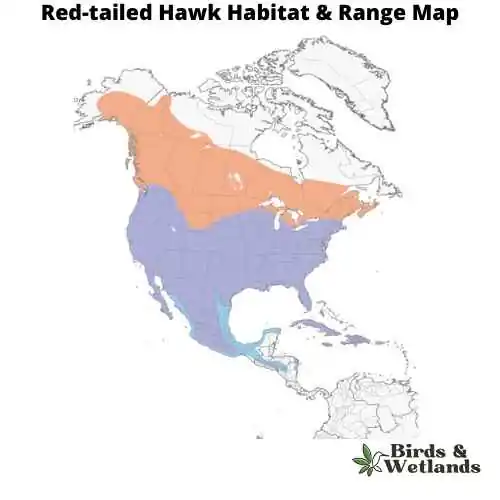
Red-tailed Hawk Sound
Red-shouldered Hawk (Buteo lineatus)
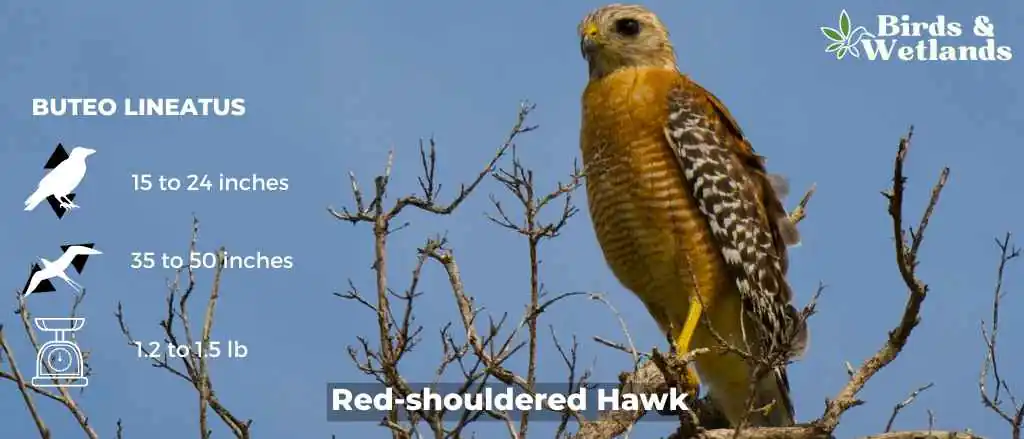

Listen:
The red-shouldered hawk are medium sized birds of prey, part of the buteo hawks family. It can be distinguished from other hawks by its reddish iris and pale legs.
The adult has rusty red upperparts, white underparts, a black chin and throat, and a reddish brown stripe over each eye, reddish brown heads and a strongly banded tail. The tail is reddish brown with two paler bands across it and they have white checkered wings. Juveniles are brown with dark barring and have pale fringes on the feathers of their wings.
Red-shouldered hawks nest in trees, though they also inhabit manmade structures including barns, bridges, and buildings. They prefer wooded areas with an open canopy but will use other places as well for nesting such as shrubs and hedges if needed.
The red-shouldered hawk’s diet – they eat small mammals such as ground squirrels, rabbits, voles, mice and rats. They also eat birds such as quail, pigeons and doves; reptiles including snakes; amphibians; fish; crustaceans; insects; and carrion (dead animals).
Cooper’s Hawk (Accipiter cooperii)
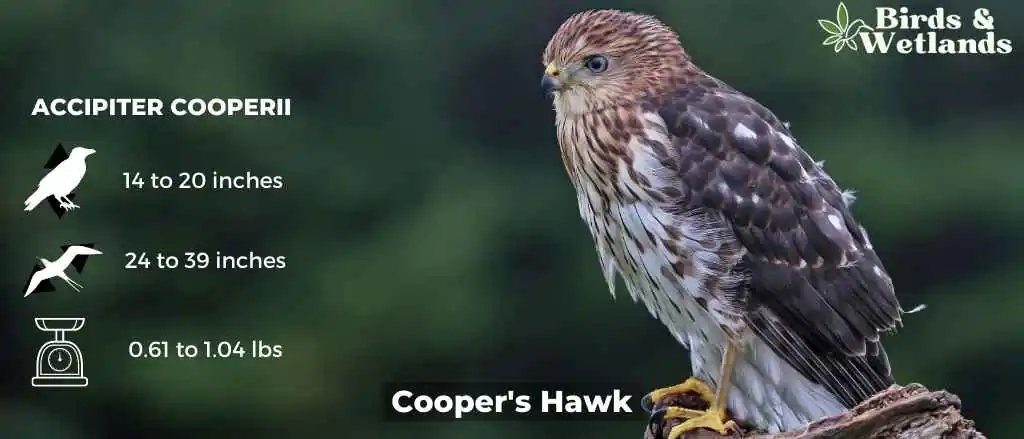
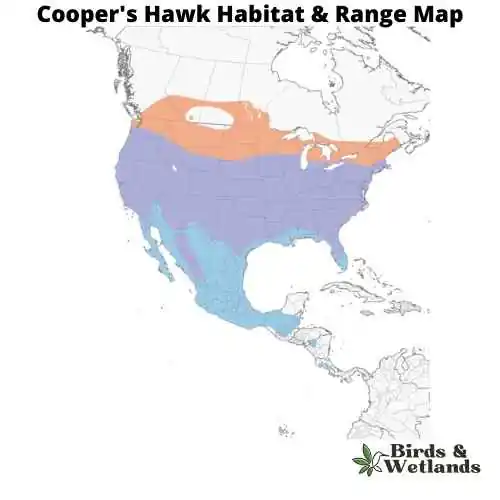
Listen:
The Cooper’s Hawk is a medium-sized bird of prey native to North America. Known for its agility and speed, it is part of the Accipitridae hawk species, which also includes other hawks, eagles, and kites.
Cooper’s Hawks are typically about 14 to 20 inches in length, with a wingspan ranging from 27 to 36 inches. They are known for their distinctive long, rounded tails and short, rounded wings. They have a steely blue gray top, with rusty bars on their underparts and thick, dark bands on their tails.
The Cooper’s Hawk is a skilled predator, primarily hunting birds and small mammals. They are adept at hunting in both dense forests and open areas, often catching prey mid-air in high-speed pursuits. They have also been known to visit the backyard bird feeder, not for the seed, but to prey on the smaller birds that gather there.
Cooper’s Hawks often build nests in dense tree canopies where they are well concealed. The female usually lays 3 to 5 eggs, and both parents share incubation duties. The young hawks fledge after about a month but will stay close to the nest, relying on their parents for food as they learn to hunt.
Bald Eagle (Haliaeetus leucocephalus)
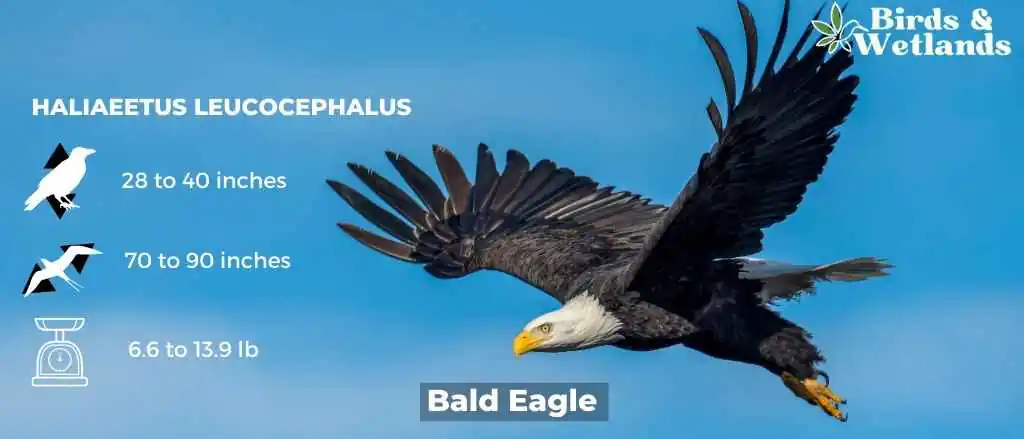
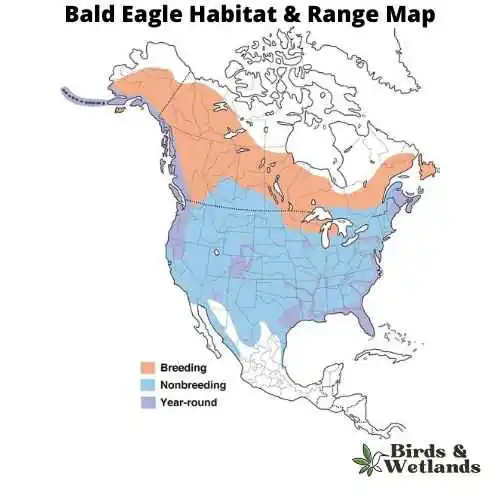
Bald Eagle Sound
Scientific Name: Haliaeetus leucocephalus
Length: 28–40 in
Wingspan: 5 ft 11 in and 7 ft 7 in
Weight: 6.6 -13.9 lb
The Bald Eagle, primarily found in Canada and Alaska, is instantly identifiable by its white head, dark brown body, yellow beak, and a piercing cry. Its sharp, orange-yellow eyes aid in efficient night hunting.
Predominantly residing in North America, occasionally venturing into Asia and Europe, it thrives near water bodies. It perches atop trees, providing a bird’s-eye view of its prey. It feeds on fish, carrion, small mammals like rabbits and squirrels, and reptiles. Hunting involves a swift downward swoop to seize the prey, carrying it back to the nest.
Bald Eagles are monogamous, forming lifelong pairings. They construct vast nests from sticks, lined with moss or grasses. They typically lay 1-3 eggs annually, which hatch around 35 days later. The fledglings leave the nest roughly 6 weeks after hatching, but continue to rely on their parents for nourishment for a further 5-6 months, until they become proficient hunters.
Great Horned Owl (Bubo virginianus)
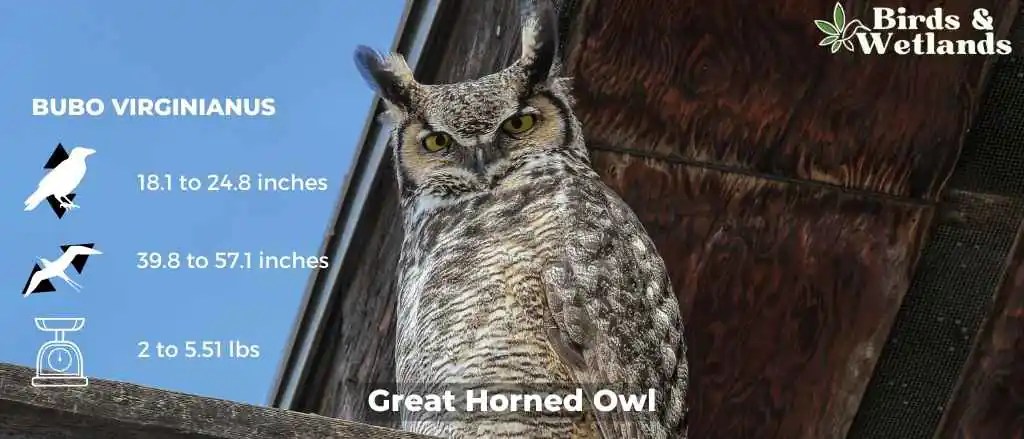

Great Horned Owl Sound
Scientific Name:Bubo virginianus
Length: 18.1-24.8 in
Wingspan: 39.8-57.1 in
Weight: 32.1-88.2 oz
The Great Horned Owl is a large owl with long wings and a large head. It’s one of the most common owls in North America.
Great Horned Owls are large, stocky birds with soft feathers that are gray to brown on their backs and white on their chests. Their faces are characterized by two black “ear” tufts, which can be raised or flattened depending on the owl’s mood. The eyes are yellow, orange, or red in color.
The habitat of the Great Horned Owl is a variety of different environments such as forests and deserts. They also live near water sources such as lakes, streams and rivers where they can hunt for fish.
The diet of the Great Horned Owl consists primarily of small mammals such as mice and rats; however they will also eat other rodents such as squirrels, rabbits and porcupines. They have been known to eat skunks too.
Osprey (Pandion haliaetus)

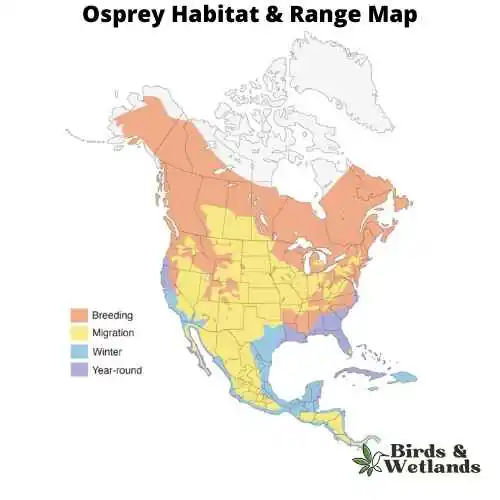
Osprey Sound
Scientific Name: Pandion haliaetus
Length: 50–66 cm (19+1⁄2–26 in)
Wingspan: 127–180 cm (50–71 in)
Weight: 0.9–2.1 kg (2 lb 0 oz – 4 lb 10 oz)
The Osprey, a fascinating bird of prey, is universally known for its exceptional hunting prowess and striking physical characteristics. Osprey are dark brown hawks on the upperparts, contrasting beautifully with the predominantly white underparts, and a distinctive dark band that stretches across the eyes towards the sides of its head.
Equipped with specialized talons and a reversible outer toe, the Osprey’s hunting strategy involves a spectacular plunge-dive into bodies of water, often emerging with a fish securely gripped in its claws.
Found on every continent except Antarctica, the Osprey is a cosmopolitan species favoring habitats near water bodies such as lakes, rivers, and coastal areas, reflecting its piscivorous diet. This bird has a diet almost exclusively of fish, making it a unique member of the raptor family and often referred to as the sea hawk or fish hawk. They locate their prey from the air, often hovering before plunging feet-first to capture a fish. When it comes to breeding, Ospreys are monogamous, often mating for life.
They construct large, bulky nests made of sticks, lined with softer materials, and prefer elevated or isolated areas such as treetops or artificial structures like utility poles. Both parents share the responsibility of incubating the eggs and rearing the chicks.
American Kestrel (Falco sparverius)


American Kestrel Sound
Scientific Name: Falco sparverius
Length: 8.7 to 12.2 in
Wingspan: 20–24 in
Weight: 3.0–5.8 oz
The American Kestrel, often recognized as the smallest and most brightly colored falcon in North America, exhibits a stunning array of rufous, blue and gray hues in its plumage. This bird, ranging in size from a mere 22 to 31 cm, carries distinct black facial markings that contrast with its white cheeks and has blue gray wings. Despite its small stature, the American Kestrel is a formidable predator, employing a unique hunting strategy that involves hovering at a height before swooping down on prey, primarily consisting of insects, small mammals, and occasionally small birds.
Residing predominantly in North and South America, the American Kestrel exhibits a preference for open habitats such as meadows, grasslands, and deserts. They are also found in both urban and suburban environments, nesting in cavities in trees, cliffs, buildings, and other structures. Kestrels are monogamous, with both sexes participating in the courtship displays that involve aerial acrobatics and feeding rituals. Nesting duties are a shared responsibility, with the male initially scouting for suitable locations and the female making the final selection. Both parents contribute to the incubation of the eggs and care of the young, ensuring the perpetuation of this captivating species.
Mississippi Kite (Ictinia mississippiensis)
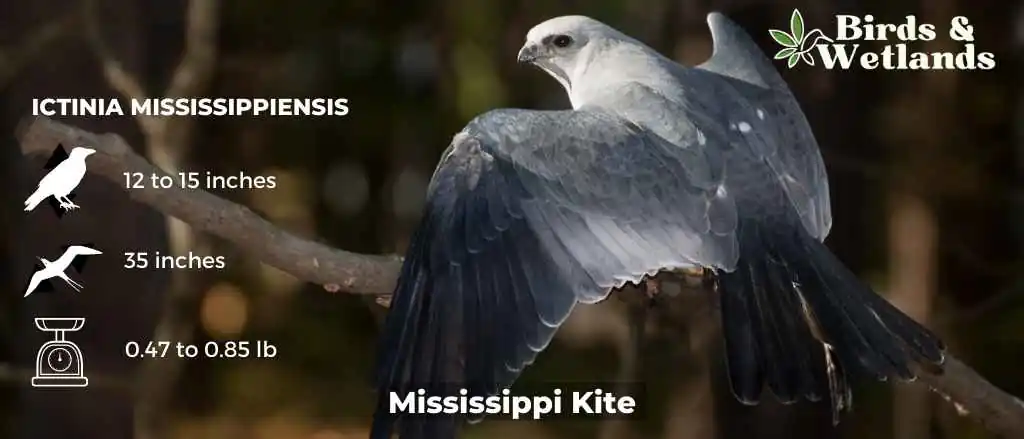
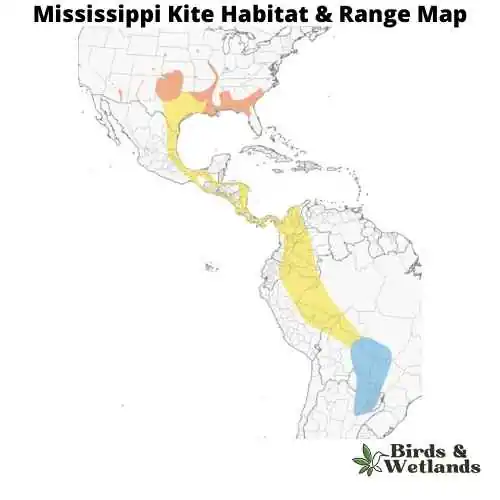
Mississippi Kite Sound
Scientific Name: Ictinia mississippiensis
Length: 12 to 15 inches (30–37 cm)
Wingspan: 3 feet (91 cm)
Weight: 214 to 388 grams (7.6–13.7 oz)
The Mississippi kite is a medium-sized bird of prey native to North America. It has a white belly and chest, with brown wings and tail and pointed wings. They have a black mask on their face, and the males have blue markings on their wings.
The Mississippi kites habitat is open grassland, including prairies, pastures, and meadows. It can also be found in wetlands such as marshes and swamps. It prefers warmer climates but can survive in cooler regions if there are many trees nearby that provide nesting sites.
The diet of these birds consists mostly of insects such as grasshoppers, beetles and dragonflies. They also eat small rodents that they catch while flying over fields or while perched on tall trees or telephone poles.
The Mississippis kite nest looks like a shallow bowl built with sticks, twigs and grasses. They lay between 2-5 eggs per year, which take about two weeks to hatch into chicks that fledge after two months. The breeding season for Mississippi Kites typically occurs from May to July
Broad-winged Hawk (Buteo platypterus)

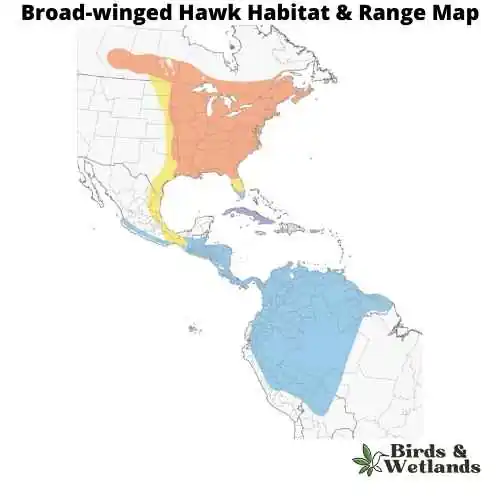
Broad-winged Hawk Sound
The Broad-winged Hawk holds a commanding presence as one of the largest hawks in the world, known for its broad wings. Its formidable size is a testament to its prowess as a bird of prey, effortlessly navigating the open skies in search of food.
Their distinctive appearance sets them apart. The adults exhibit a striking black and white pattern, complemented by a rusty breast and buff underparts and brown wings. In contrast, juveniles are adorned with a brown plumage, marked by pale edges on their feathers, adding to their distinctive youthful charm.
These hawks are most commonly found in open areas, such as farmlands or grasslands interspersed with scattered trees, which provide optimal conditions for when hawks hunt.
When it comes to their diet, Broad-winged Hawks feed on small rodents like mice, rats, squirrels, rabbits, and voles. Broad winged hawks breed during the spring and summer months then migrate to central and south America.
Northern Harrier (Circus hudsonius)

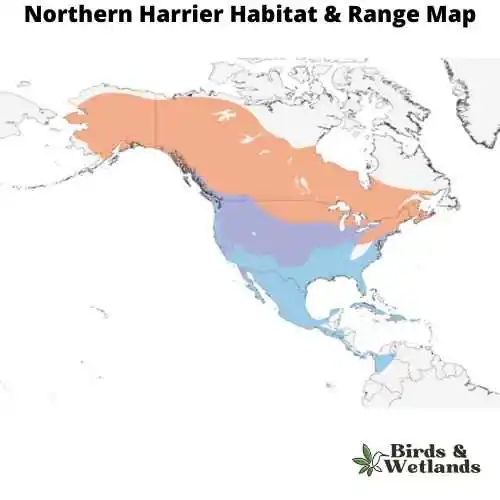
Listen:
The Northern Harrier is a medium-sized, slender hawk.
Adult birds are gray above, with pale bars on the wing feathers and white markings on the underwings and a white rump patch. The breast is barred with black and white, and the belly is streaked with brown.
They prefer open areas, such as grasslands and marshes, but can be found in almost any open habitat except dense woods.
Northern Harriers are opportunistic hunters that feed on small mammals such as mice, voles and rabbits as well as birds including quail, grouse and ducks. They hunt by flying low over open spaces such as fields or marshes.
Northern harrier nests on the ground in lowlands or hillsides near water bodies. It lays two to four eggs which hatch after 24 days of incubation by both parents. The chicks fledge after 30 days of hatching and remain dependent on their parents for another three weeks during which they learn how to fly.
/Swallow-tailed Kite
Barred Owl (Strix varia)


Barred Owl Sound
Scientific Name: Strix varia
Length: 40 to 63 cm (16 to 25 in)
Wingspan: 96 to 125 cm (38 to 49 in)
Weight: 468 to 1,150 g
The Barred Owl is a medium-sized owl with a barred pattern on its chest and belly. They have large yellow eyes that allow them to see well in low light conditions. Their ears are not very large which means they do not hear very well but they have excellent hearing abilities which allow them to detect sounds up to 1 mile away. Their feathers are brown and streaked with white, and they have black bars on their chests and wings.
Their habitats include forests, woodlands, orchards, parks, farmland and suburban backyards.
Barred Owls (also known as hoot owl) eat small mammals such as mice, rats and squirrels. They also eat insects such as beetles or grasshoppers. These owls hunt during the day when it is light out so that they can see their prey better than at night when they would be using senses other than sight like sound or smell to find their food source.
Barred owls are monogamous birds which means they mate for life. They build nests in trees or cavities on the ground and lay 2-4 eggs per year. The incubation period for these eggs lasts about 28 days before hatching takes place.
Peregrine Falcon (Falco peregrinus)


Peregrine Falcon Sound
Scientific Name: Falco peregrinus
Length: 14.2-19.3 in
Wingspan: 39.4-43.3 in
Weight: 530-1600 g
Known for its blue-gray plumage and unique cheek bars, the Peregrine Falcon stands as a beacon of power and swiftness. Despite its modest size, it reigns as the world’s fastest creature, reaching staggering speeds up to 240 mph during hunting dives.
Its diet mainly includes birds, occasionally bats, caught in an enthralling aerial display of agility and precision. Adapting to diverse habitats, this bird graces every continent except Antarctica, finding home in environments from city skyscrapers to towering cliffs.
Peregrine Falcons, monogamous in nature, often pair for life, expressing their bonds through complex courtship flights filled with intricate aerial maneuvers. They construct simple scrape nests on high ledges, often without adding materials.
Their parenting duties are shared, from egg incubation to feeding and caring for the chicks, ensuring their offspring are ready to take on the skies in their own time.
Northern Saw-whet Owl (Aegolius acadicus)
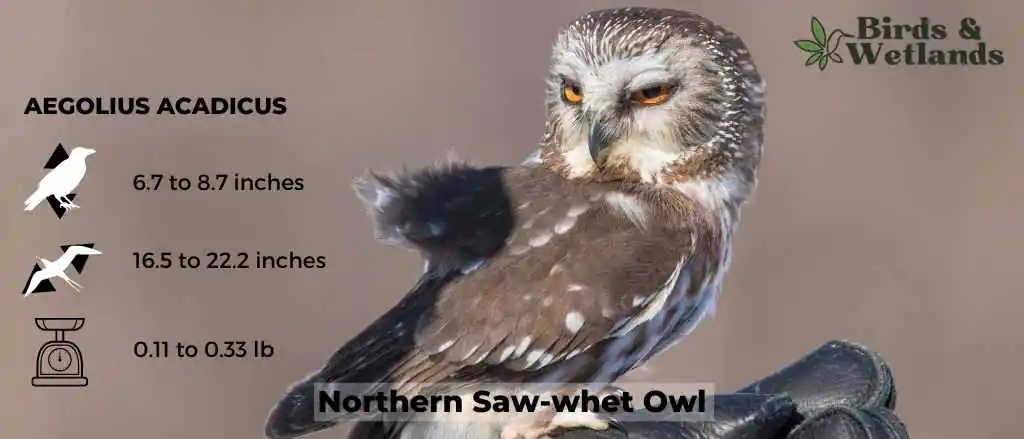

Northern Saw-whet Owl Sound
Scientific Name: Aegolius acadicus
Length: 17–22 cm (6.7–8.7 in)
Wingspan: 42–56.3 cm (16.5–22.2 in)
Weight: 54 to 151 g (1.9 to 5.3 oz)
The Northern Saw-whet Owl is a tiny, speckled gray owl and it’s one of the smallest owls in North America. It’s also known as the Little Owl or Wood Owl in some areas.
Northern Saw-whet Owls have dark brown eyes, white eyebrows, and yellow beak. It has brownish-grey feathers that are spotted with white. The owl’s legs are covered in feathers and appear nearly invisible when the bird is perched on a branch or tree.
In the winter they migrate south to warmer climates. They prefer to live in dense coniferous forest with large trees but will occasionally nest in shrubs or other vegetation that can protect them from predators.
The Northern Saw-whet Owl eats mice and voles (small rodents), small birds, frogs, salamanders, moles and shrews, but unlike most owls they chop their prey up and spread over a few meals. They will also eat insects like beetles and grasshoppers if they are available. It hunts from a perch at night using its excellent hearing to locate prey items within about 30 feet (9 meters) of its nest.
These owls nest in tree cavities usually located close to water sources such as lakes or rivers where they can find their food source (insects). They lay 2-4 eggs at one time which incubate for about 30 days before hatching.
Sharp-shinned Hawk (Accipiter striatus)
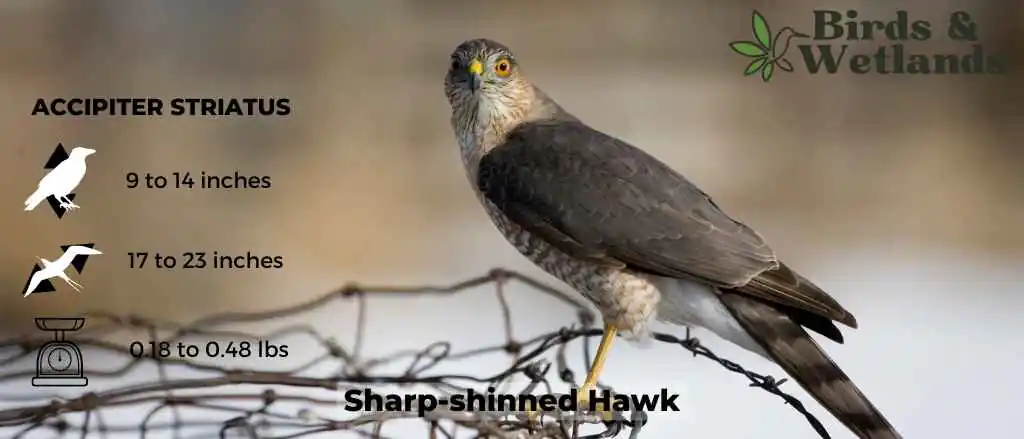
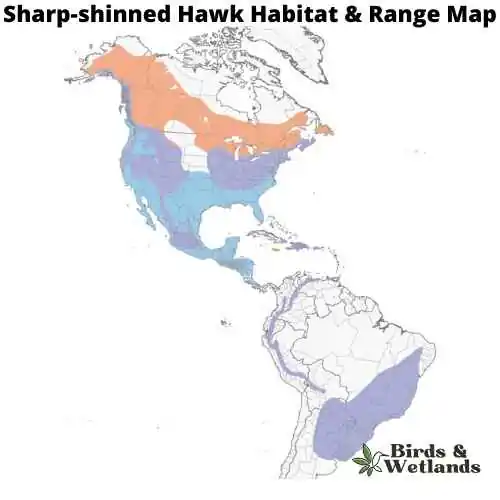
Listen:
The adult bird is brown on top and white underneath, with a dark brown band across its chest. It has short, rounded wings and a long tail that makes it look larger than it actually is. Adult sharp shinned hawks have black eyes, which are surrounded by white feathers. The female Sharp-shinned Hawk is browner than the male, who has darker brown markings on his back.
Sharp-shinned Hawks prefer open country for their habitat, including fields and meadows where they can hunt for mice and other small animals. They can be found throughout the United States but are most common in the east.
Sharp-shinned Hawks eat mostly small birds, such as sparrows and warblers, as well as small mammals such as mice and gophers. They catch prey by surprise using their incredible speed and agility, diving out of the sky at speeds up to 200 mph.
Sharp-shinned Hawks have an unusual hunting style for hawks—they prefer to catch their prey from perches above trees or telephone wires, rather than swooping down from above like most other hawks do and can often be seen hunting near bird feeders.
Merlin (Falco columbarius)


Merlin Sound
Scientific Name: Falco columbarius
Length: 9.4–13.0 in
Wingspan: 20–29 in
Weight: 5.8 – 8.1 ozz
The Merlin is a small, robust falcon known for its blue-gray or dark brown upperparts and thinly streaked, buff to orange underparts. Unlike other falcons, it has faint facial markings, offering a more uniform look.
This compact bird, renowned for its hunting prowess, chases down small birds in mid-air, exemplifying its impressive speed and agility.
Residing across northern North America, Europe, and Asia, the Merlin prefers open or semi-open landscapes. Rather than constructing their own nests, they tend to reuse old crow or raptor nests, or choose to nest on the ground in open habitats.
During courtship, males perform elaborate aerial displays. Both parents share egg incubation duties, with the male also responsible for feeding the family, reflecting the Merlin’s fascinating role in the biodiversity of its ecosystems.
Northern Goshawk (Accipiter gentilis)
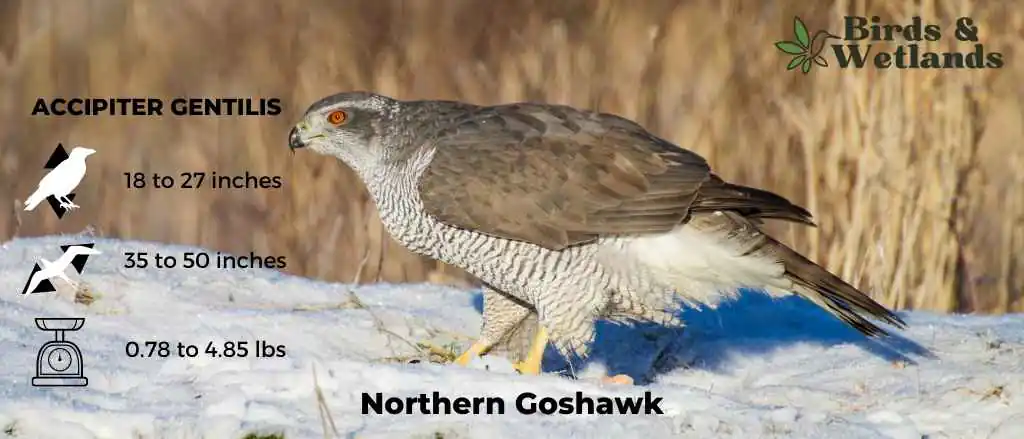

Listen:
The Northern Goshawk is a medium-sized hawk that is found in North America, Europe and Asia. It has brown eyes, a large sharp beak, and dark brown plumage on its upperparts and head, with white underparts that are spotted with brown barring. Its tail feathers are grayish-black with a dark band near the tip.
Northern goshawks eat squirrels, rabbits, grouse, woodchucks and other small mammals like voles or mice (which they often eat whole). They will also take larger prey such as deer fawns or even adult deer if they have no other choice. They have broad wings with long feathers that allow them to glide through the air when they catch their prey. They also have an excellent sense of smell which helps them locate their food source.
The Northern Goshawk builds its nest in a tree cavity or on a ledge, usually on the edge of an open area so it can easily see prey below. The female lays 3 to 5 eggs over two days and incubates them for 28 to 30 days while the male brings food to her every few hours until they hatch. The young fledge after about 6 weeks and leave the nest when they are about 10 weeks old.
Eastern Screech-Owl (Megascops asio)
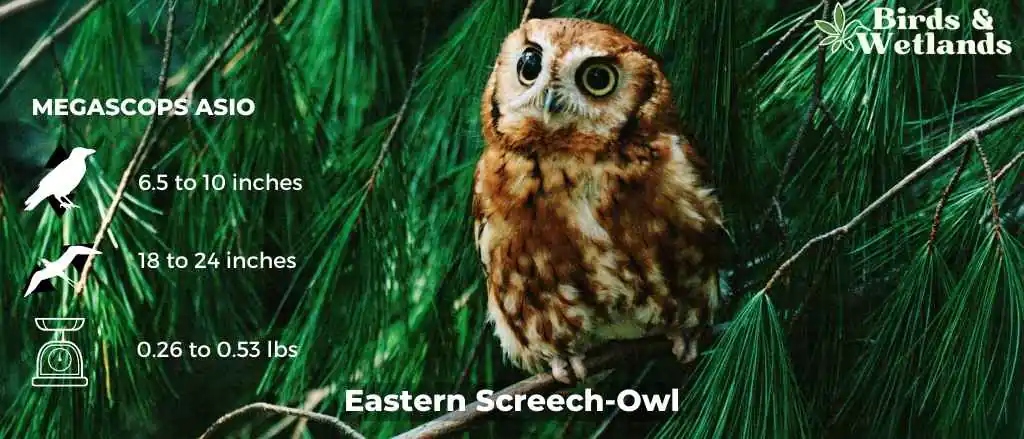
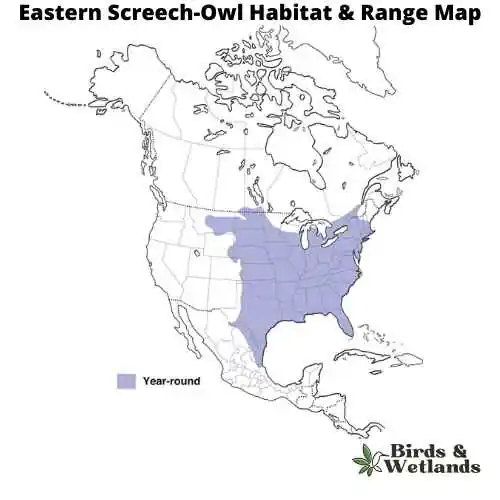
Eastern Screech-Owl Sound
Scientific Name: Megascops asio
Length: 6 to 10 in
Wingspan: 8 to 24 in
Weight: 4 – 8.5 oz
The Eastern Screech-Owl is a small owl species native to most wooded environments of the eastern half of North America, from the Canadian provinces to Florida and Texas.
Eastern Screech-Owls are relatively small and exhibit a complex pattern of gray or reddish-brown coloration, which provides excellent camouflage against tree bark.
These owls are known for their distinctive call, which is often described as a haunting trill or a whinny-like sound. Despite their name, they do not actually produce a “screech.”
Eastern Screech-Owls feed on a variety of prey, ranging from small mammals and birds to insects and even earthworms. It is primarily nocturnal, hunting at night from a low perch and swooping down onto prey.
Eastern Screech-Owls nest in tree cavities or abandoned woodpecker nests, but they readily adapt to nesting boxes where natural cavities are not available. They typically lay between 2 to 6 eggs, which are incubated primarily by the female.
Top Places to Spot Preying Birds in Alabama
Alabama offers several fantastic locations to spot a diverse array of birds of prey. Here are the top locations known for their abundance and diversity of Birds of Prey in the state:
Wheeler National Wildlife Refuge: Located along the Tennessee River near Decatur, Wheeler National Wildlife Refuge provides a prime habitat for birds of prey. The refuge’s wetlands, forests, and open fields attract a variety of raptors, including Bald Eagles, Ospreys, Red-tailed Hawks, and Mississippi Kites. Visitors can explore the refuge’s trails, observation decks, and drive the scenic Wildlife Drive to observe these magnificent birds in their natural habitats.
Bankhead National Forest: Situated in northwest Alabama, Bankhead National Forest offers a mix of upland forests, hardwood bottoms, and scenic rivers. This diverse landscape attracts a range of birds of prey, such as Barred Owls, Red-shouldered Hawks, Cooper’s Hawks, and Broad-winged Hawks. Exploring the forest’s trails and listening for the hoots of owls or the piercing calls of hawks can provide exciting encounters with these majestic birds.
Gulf State Park: Located on the coast of Alabama, Gulf State Park is not only a popular destination for beachgoers but also an excellent spot for birdwatching. The park’s diverse habitats, including coastal dunes, marshes, and woodlands, attract a variety of raptors. Visitors may spot American Kestrels perched on utility lines, Swallow-tailed Kites gracefully soaring overhead, and Ospreys hunting along the shoreline.
Wheeler Dam: Situated on the Tennessee River in northern Alabama, Wheeler Dam provides prime opportunities for observing birds of prey. The area near the dam attracts an abundance of fish, which, in turn, attracts birds such as Bald Eagles and Ospreys. Visitors can watch these majestic birds fishing or soaring in the vicinity of the dam, offering thrilling birdwatching experiences.
Little River Canyon National Preserve: Located in northeastern Alabama, Little River Canyon National Preserve is a stunning landscape of deep gorges, waterfalls, and dense forests. This preserved wilderness serves as a haven for a variety of birds of prey, including Red-tailed Hawks, Sharp-shinned Hawks, and Great Horned Owls. Exploring the park’s scenic overlooks and hiking trails provides opportunities to observe these birds in their natural habitats.
Continue your journey eastward to the birds of prey in Georgia. Venturing north, the rolling hills and sprawling forests of Tennessee become a living tableau of hawk-watching opportunities, see preying birds in Tennessee . Then, let the mighty Mississippi River show you the Mississippi raptors. Finally, journey into the bayous of Louisiana, to capture birds of prey in Louisiana.
Are Birds of Prey in Alabama protected by law?
Yes, birds of prey in Alabama are protected by both state and federal laws. It is illegal to harm, disturb, or possess these birds without the necessary permits. Report any violations to the appropriate wildlife authorities.
What should I do if I find an injured or orphaned bird of prey in Alabama?
If you encounter an injured or orphaned bird of prey, contact a licensed wildlife rehabilitator in Alabama. Do not attempt to handle or care for the bird yourself, as they require specialized care and expertise.
How can I attract birds of prey to my backyard in Alabama?
To attract birds of prey to your backyard, provide suitable habitat elements like perches, nesting platforms, and food sources such as bird feeders or open areas for hunting. Consult local birding resources for specific tips and recommendations.
Can I own a bird of prey as a pet in Alabama?
No, it is illegal to possess or keep birds of prey as pets in Alabama without the required permits and licenses. Birds of prey are wild animals and require specialized care and environments.

